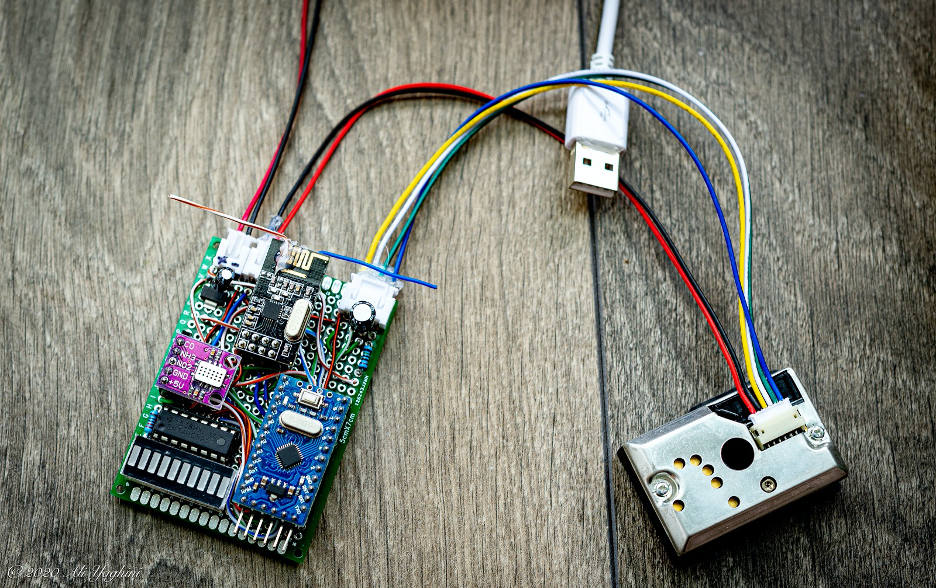
Introduction
This project aims to automate and enhance the process of monitoring indoor air quality. The following parameters re monitored, stored and being transferred to my server:
- Temperature
- Carbon monoxide CO
- Nitrogen dioxide NO2
- Ethanol C2H6OH
- Hydrogen H2
- Ammonia NH3
- Methane CH4
- Propane C3H8
- Iso-butane C4H10
- PM1.0, PM2.5, and PM10
I am using the same architecture as the post #1. The NRF24 is used for the data transfer to my Gateway.
My Take
I found the Sharp sensor easy to integrate but not very accurate, a reason could be the fact that mine didn’t come with a fan to circulate the air within the sensor optic, one needs to investigate it.
Misc-6814 is a typical MEMS sensor that can detect the presence of multiple gases and the shortcoming is that it cannot tell you which gas. The sensor also needs calibration.
Dallas ds18820 is amazing, whether it needs some calibration would be my question!
The Arduino pro mini is performing very well!
last but certainly not least, the 10 segments LED is very useful and also easy to implement using the 74HC595, I was lucky to have couple of those around!
Sensors
Sharp GP2Y1010AU0F Dust Sensor
This is an optical air quality sensor, with an analog output proportional to the measured dust density, with a sensitivity of 0.5V/0.1mg/m3.
Below is a code I borrowed from the URL in the comment section, all credits go to authors.
/*
Standalone Sketch to use with a Arduino Fio and a
Sharp Optical Dust Sensor GP2Y1010AU0F
Blog: http://arduinodev.woofex.net/2012/12/01/standalone-sharp-dust-sensor/
Code: https://github.com/Trefex/arduino-airquality/
For Pin connections, please check the Blog or the github project page
Authors: Cyrille Médard de Chardon (serialC), Christophe Trefois (Trefex)
Changelog:
2012-Dec-01: Cleaned up code
This work is licensed under the
Creative Commons Attribution-NonCommercial-ShareAlike 3.0 Unported License.
To view a copy of this license, visit http://creativecommons.org/licenses/by-nc-sa/3.0/
or send a letter to Creative Commons, 444 Castro Street, Suite 900,
Mountain View, California, 94041, USA.
*/
int measurePin = A0;
int ledPower = 12;
int samplingTime = 280;
int deltaTime = 40;
int sleepTime = 9680;
float voMeasured = 0;
float calcVoltage = 0;
float dustDensity = 0;
void setup(){
Serial.begin(9600);
pinMode(ledPower,OUTPUT);
}
void loop(){
digitalWrite(ledPower,LOW); // power on the LED
delayMicroseconds(samplingTime);
voMeasured = analogRead(measurePin); // read the dust value
delayMicroseconds(deltaTime);
digitalWrite(ledPower,HIGH); // turn the LED off
delayMicroseconds(sleepTime);
// 0 - 3.3V mapped to 0 - 1023 integer values
// recover voltage
calcVoltage = voMeasured * (3.3 / 1024);
// linear eqaution taken from http://www.howmuchsnow.com/arduino/airquality/
// Chris Nafis (c) 2012
dustDensity = 0.17 * calcVoltage - 0.1;
Serial.print("Raw Signal Value (0-1023): ");
Serial.print(voMeasured);
Serial.print(" - Voltage: ");
Serial.print(calcVoltage);
Serial.print(" - Dust Density: ");
Serial.println(dustDensity);
delay(1000);
}
MICS-6814
This is a compact MEMS sensor with three independent sensing elements on one package.
You can find the datasheet here: MISC-6814
and to learn more about how to work with this sensor: MISC-6814 Project
Dallas DS18820
This is a famous temperature sensor. Please have a look at Arduino project here: DS18820 Project
10 Segments LED
To provide user with some sort of visual feedback, I decided to use one of these 10 segments LEDs I had around for ages.
To use them I needed to use 74HC595 - Serial to Parallel Converter. Adafruit has a great tutorial: Adafruit Shift Register